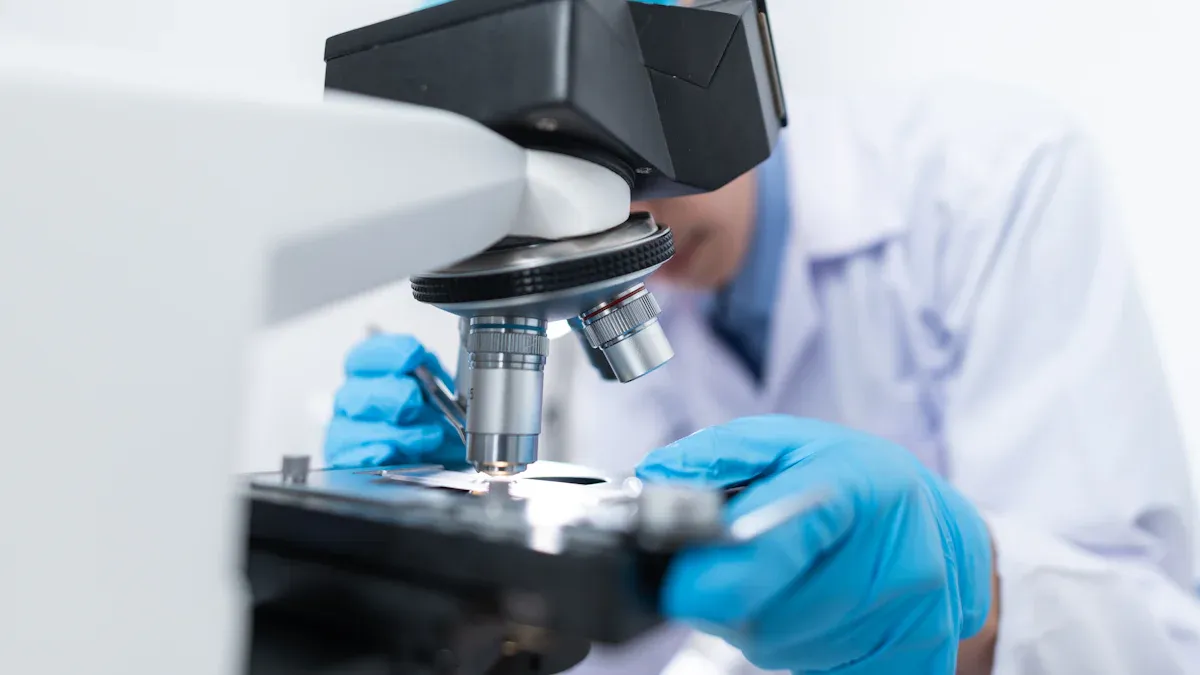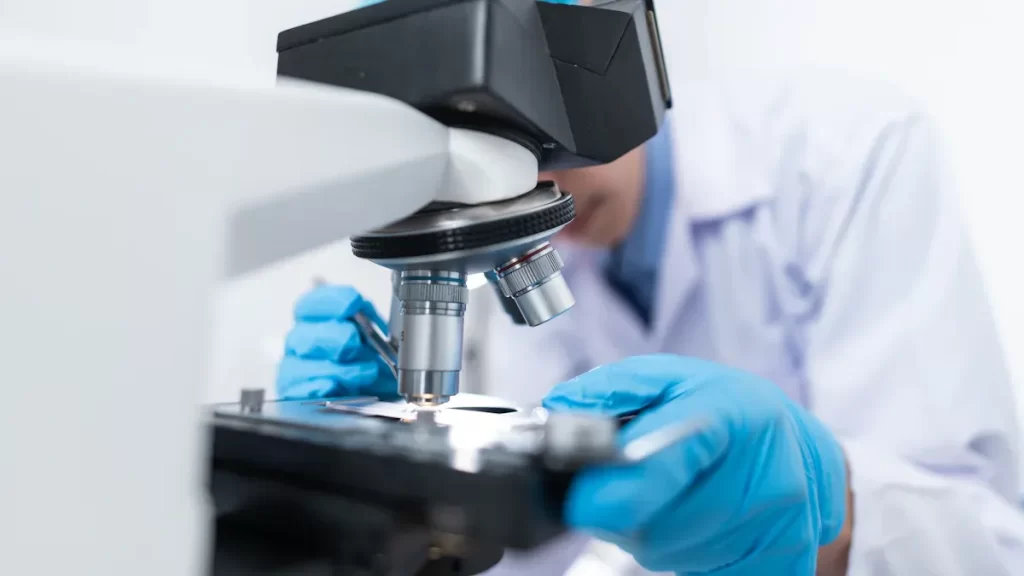News & Events
Endomysial Antibody IgA: Never Ignore These Celiac Signs

You may wonder what endomysial antibody IgA is. This antibody helps doctors find celiac disease by showing if your immune system reacts to gluten. Spotting signs of celiac disease early helps you avoid years of discomfort. Many people miss these signs. In Finland, over half of celiac disease patients waited more than three years for a diagnosis. Some adults even faced delays of up to 12 years. These delays can make you feel worse and need more medical care. Proper testing with IgA can give you answers faster and help you feel better.
Key Takeaways
- Endomysial antibody IgA is crucial for diagnosing celiac disease. It shows how your immune system reacts to gluten, helping doctors identify the condition early.
- If you experience symptoms like diarrhea, fatigue, or unexplained weight loss, ask your doctor about testing for celiac disease. Early detection can prevent long-term health issues.
- Doctors often use both tTG-IgA and EMA-IgA tests together. This combination improves diagnostic accuracy and reduces the chance of false results.
- Always continue eating gluten before testing. Stopping gluten can lower antibody levels and affect the accuracy of your test results.
- If diagnosed with celiac disease, follow a strict gluten-free diet. This can significantly improve your quality of life and reduce health risks.
Endomysial Antibody IgA in Celiac Disease
What Is Endomysial Antibody IgA?
You may hear your doctor talk about endomysial antibody IgA when discussing celiac disease. This antibody is a special type of IgA that targets the lining of your intestinal muscles. When you have celiac disease, your immune system makes this antibody after you eat gluten. The presence of endomysial antibody IgA in your blood can signal that your body is reacting to gluten in a harmful way. Doctors use this antibody as part of celiac antibody tests to help find out if you have celiac disease.
Note: In some studies, like the DESIR cohort, researchers found that none of the 708 patients tested positive for serum endomysial antibodies. This shows that endomysial antibody IgA is rare in people without biopsy-confirmed celiac disease.
How It Detects Celiac Disease
Endomysial antibody IgA helps doctors spot celiac disease by showing how your immune system reacts to gluten. When gluten enters your body, your immune system may create both IgA and IgG antibodies against tissue transglutaminase (tTG) and endomysium. These antibodies attack your intestinal lining, causing damage. You can see how this works in the table below:
| Aspect | Detail |
|---|---|
| Presence in Celiac Disease | IgA class endomysial antibodies (EMA) are found in most celiac patients. |
| Specificity | High specificity for villous atrophy (VA). |
| Sensitivity | Varies from 74% to 98%, depending on the severity of the duodenal lesion. |
| Relationship | EMA generation is an immune response to gliadin and tissue transglutaminase (tTG) complexes. |
| Histological Recovery | Seroconversion may not indicate histological recovery after gluten exclusion. |
Doctors use serum antibody measurement to check for these antibodies. If you have biopsy-confirmed celiac disease, you will likely test positive for both tTG and EMA IgA.
Role in Diagnostic Testing
Endomysial antibody IgA plays a key role in the diagnosis and management of celiac disease. Doctors often use both tTG IgA and EMA IgA tests to increase diagnostic accuracy. The diagnostic accuracy of tTG IgA is high, with over 90% sensitivity and specificity. The diagnostic accuracy of EMA IgA is even higher for specificity, making it the gold standard in serologic testing. You may see your doctor order both tests before recommending an intestinal biopsy. The combination of these tests helps reduce false results and gives you a clearer answer. Automated tests now make it easier to check for these antibodies, improving the process for both you and your doctor.
tTG-IgA and Its Diagnostic Role
What Is tTG-IgA?
You may hear your doctor mention tTG-IgA when talking about celiac disease. This test looks for an antibody called immunoglobulin A (IgA) that targets tissue transglutaminase. Tissue transglutaminase is an enzyme found in your intestines. When you have celiac disease, your immune system makes this antibody after you eat gluten. The tTG-IgA test checks your blood for this specific antibody. If you have high levels of tTG-IgA, it often means your body is reacting to gluten in a way that damages your intestines.
Sensitivity and Screening Power
Doctors trust the tTG-IgA test because it works well for screening celiac disease. You get a test that is both sensitive and specific. Here is what that means for you:
- tTG-IgA sensitivity exceeds 90%. This means the test finds most people who have celiac disease.
- Specificity is more than 95%. The test rarely gives a positive result if you do not have the disease.
- Positive predictive value is 89.4%. If your test is positive, there is a high chance you have celiac disease.
- Negative predictive value is 99.0%. If your test is negative, you almost certainly do not have the disease.
You can see that tTG-IgA stands out among other antibody tests. For example, tTG-IgA has a sensitivity of 0.93 and a specificity of 0.98. These numbers are higher than many other tests, making tTG-IgA a strong choice for your diagnostic journey.
When tTG-IgA Is Used
Doctors use tTG-IgA as the first step when they suspect celiac disease. You may get this test if you have symptoms like stomach pain, diarrhea, or tiredness. Children often get tTG-IgA testing first, following the ESPGHAN 2020 guidelines. These guidelines even allow some children to skip a biopsy if their tTG-IgA levels are very high. In the United States, doctors follow NASPGHAN 2016 guidelines. They recommend tTG-IgA for anyone over age 3 or for people with other autoimmune conditions. You may get this test even if you do not have symptoms, especially if you have a family history of celiac disease. The tTG-IgA test helps your doctor decide if you need more tests or a biopsy.
Tip: Always keep eating gluten before your tTG-IgA test. Stopping gluten can lower your antibody levels and affect your results.
EMA-IgA vs tTG: Diagnostic Differences
Sensitivity vs Specificity
When you look at celiac disease testing, you often hear about sensitivity and specificity. These two words help you understand how well a test works. Sensitivity shows how often a test finds people who have the disease. Specificity shows how often a test avoids false alarms in people who do not have the disease.
You can see the differences between tTG-IgA and EMA-IgA in the table below:
| Test | Sensitivity | Specificity |
|---|---|---|
| tTG-IgA | 87.5% | 95.4% |
| EMA-IgA | 77.5% | 97.3% |
| tTG-IgA ≥10x ULN | N/A | 99.3% |
tTG-IgA finds more people with celiac disease because it has higher sensitivity. EMA-IgA almost never gives a false positive, so it has higher specificity. If you test positive for EMA-IgA, you almost always have celiac disease. However, some people with celiac disease may not show EMA-IgA in their blood. This means EMA-IgA is less sensitive than tTG-IgA.
Practical Testing Differences
You may wonder how these tests work in real life. tTG-IgA is the first test most doctors use. It works well for screening because it catches more cases. EMA-IgA is more specific, so doctors use it to confirm a diagnosis. Both tests look for IgA antibodies, but they target different parts of your body. tTG-IgA targets tissue transglutaminase, while EMA-IgA targets the endomysium.
Here is a table that shows how false positives and false negatives compare:
| Test Type | Sensitivity | Specificity | False Positives | False Negatives |
|---|---|---|---|---|
| tTG-IgA | 93% | 96% | Higher in certain populations | Possible in some cases |
| EMA-IgA | Lower than tTG-IgA | Almost 100% | Rarely occurs | 5-10% of celiac patients may test negative |
You see that tTG-IgA can give false positives, especially in people with other autoimmune diseases. EMA-IgA almost never gives a false positive, but it can miss some people who have celiac disease. About 5-10% of people with celiac disease may test negative for EMA-IgA. This is why doctors often use both tests together.
Note: Both tests measure IgA antibodies. If you have IgA deficiency, these tests may not work. Doctors may check your total IgA level first. If you have low IgA, they may use other tests, like DGP-IgG.
When to Use Each Test
Doctors follow clinical guidelines to choose the right test for you. Most start with tTG-IgA because it has high sensitivity and works well for screening. If your tTG-IgA is positive, your doctor may order an EMA-IgA test to confirm the result. This approach helps reduce false results and gives you a more accurate diagnosis.
If you have symptoms of celiac disease but test negative for both tTG-IgA and EMA-IgA, your doctor may check your total IgA. Some people have IgA deficiency, which makes these tests less reliable. In this case, your doctor may use a different antibody test, such as DGP-IgG. For young children, some guidelines suggest using both tTG-IgA and DGP-IgG, but this is still debated.
You get the best results when your doctor uses both tTG-IgA and EMA-IgA. tTG-IgA helps find most cases, while EMA-IgA confirms the diagnosis. This combination improves diagnostic accuracy and reduces the chance of false positives or negatives. You can trust your results more when both tests agree.
Tip: Always keep eating gluten before testing. Stopping gluten can lower your antibody levels and make the tests less accurate.
Why Both IgA Tests Matter for Celiac Disease
Complementary Strengths
You may wonder why doctors use both tTG and EMA tests when checking for celiac disease. Each test has unique strengths. tTG IgA offers high sensitivity and catches most people with the disease. EMA IgA stands out for its high specificity, so it almost never gives a false positive. When you combine these two tests, you get a more complete picture of your health.
Here is a table that shows how these tests compare:
| Test Type | Sensitivity | Specificity |
|---|---|---|
| tTG-IgA | High | High |
| EMA-IgA | 95% | 99% |
| DGP IgA/Gg | Superb | Similar |
Doctors often use EMA testing when tTG results are unclear. A positive EMA result strongly points to celiac disease, even if your intestinal damage is mild. Using both tests together improves the diagnostic accuracy of tTG IgA and EMA IgA, especially in young children or people with IgA deficiency. You benefit from this approach because it helps your doctor make a more confident diagnosis and avoid missing cases.
Reducing False Positives and Negatives
No single test is perfect. If you rely on just one, you might get a false positive or a false negative. tTG IgA can sometimes give a positive result in people with other autoimmune diseases. EMA IgA rarely gives a false positive, but it can miss some people who truly have celiac disease.
Using both tests together helps reduce these errors:
- tTG IgA finds most cases, but EMA IgA confirms the diagnosis.
- If you have IgA deficiency, both tests may be negative even if you have celiac disease. In this case, your doctor may order IgG-based celiac antibody tests.
- Celiac disease is mainly driven by tissue transglutaminase antibodies of the IgA type. Some people have a higher risk of IgA deficiency, so doctors check your total IgA first.
- The discovery of EMA in 1980 and tTG in 1997 improved the diagnosis and management of celiac disease. The introduction of tTG autoantibodies using ELISA made testing more accurate.
When you use both tests, you lower the chance of a wrong result. This means you are less likely to need an unnecessary intestinal biopsy or miss a diagnosis.
Improving Diagnostic Confidence
You want answers you can trust. Combining tTG IgA and EMA IgA gives you that confidence. Studies show that using both tests together serves as an excellent marker for diagnosing celiac disease in both children and adults. This approach works well even when serologic tests alone do not give a clear answer.
Doctors have found that double positivity—when both tTG and EMA are positive—almost always means you have biopsy-confirmed celiac disease. In one study, patients who tested positive for both tTG IgA and DGP IgG had a predictive value of 92.5% for celiac disease. If your results show double positivity at more than ten times the upper limit of normal, the chance of having Marsh 3 intestinal damage reaches 100%. This level of certainty helps your doctor decide if you need an intestinal biopsy or if you can start treatment right away.
You can see that neither test alone is perfect. When you combine them, you get a clearer, more reliable answer. This helps you and your doctor make the best choices for your health.
Tip: Always talk to your doctor about which celiac antibody tests are right for you. The right combination can save you time, worry, and unnecessary procedures.
Celiac Disease Signs You Shouldn’t Ignore

Common Symptoms
You may notice several symptoms if you have celiac disease. Your body reacts to gluten, and this triggers your immune system to produce iga antibodies. These antibodies attack your intestinal lining. You might feel tired or lose weight without trying. Many people experience stomach problems. Here are some of the most common signs:
- Diarrhea
- Constipation
- Bloating or gas
- Fatigue
- Weight loss
- Mouth sores
- Headaches or migraines
- Itchy skin rash
- Anemia
- Bone loss
- Dental problems
- Delayed growth in children
Your doctor may check for ttg and ema antibodies if you show these symptoms. The diagnostic accuracy of ema iga helps confirm your diagnosis. You should not ignore these signs, as untreated celiac disease can damage your intestinal health.
Subtle or Atypical Signs
Some people do not have stomach symptoms. You may have celiac disease even if you feel fine most days. Atypical signs can affect other parts of your body. You might notice changes in your skin, bones, or mood. Look for these less obvious symptoms:
- Dermatitis herpetiformis (skin rash)
- Iron-deficiency anemia
- Short stature
- Osteopenia or osteoporosis
- Dental enamel defects
- Psychiatric disorders
- Migraines
- Aphthous ulcers
- Stomatitis
- Elevated liver enzymes
- Arthritis or joint pain
- Peripheral neuropathy
Less than 40% of patients now show diarrhea as their main symptom. Children with short stature and no stomach complaints may still have celiac disease. Your doctor uses ttg and ema antibody tests to improve sensitivity and specificity in diagnosis and management of celiac disease.
When to Seek Diagnostic Testing
You should ask your doctor about diagnostic testing if you notice any of these symptoms. Your doctor will likely start with serologic tests, such as ttg iga and ema iga. These tests check for antibody levels in your blood. If your results are positive, your doctor may recommend a small bowel biopsy to look for intestinal damage. The table below shows when to seek testing:
| Clinical Criteria for Celiac Disease Diagnosis | Description |
|---|---|
| Serologic Tests | Initial tests include ttg and ema antibody testing due to high sensitivity and specificity. |
| Small Bowel Biopsy | Confirms diagnosis by showing intestinal damage. |
| Referral for Endoscopy | Needed if tests are positive or suspicion remains high. |
You should not wait if you have unexplained symptoms. Early testing helps protect your intestinal health and improves your quality of life.
Next Steps if You Suspect Celiac Disease

When to Request IgA and tTG Tests
If you notice symptoms like chronic diarrhea, bloating, or abdominal pain, you should talk to your doctor about testing for celiac disease. You may also need testing if you have a family history or other autoimmune conditions. Doctors usually start with serologic tests that measure your iga, ttg, and sometimes dgp levels. Eating gluten before testing is important because it helps your body produce enough antibody for accurate results.
Here is a simple table to show the recommended steps:
| Step | Recommendation |
|---|---|
| 1 | Begin with serologic tests for ttg and/or dgp, and consider HLA typing. |
| 2 | If positive, move to a duodenal biopsy to check for intestinal damage. |
| 3 | If negative, consider genetic testing for HLA DQ2/DQ8. |
| 4 | If you have the gene but negative tests, a gluten challenge may be needed. |
| 5 | Gluten challenge means eating 2-3 grams of gluten daily for two weeks. |
Tip: Always keep eating gluten before your iga and ttg tests. Stopping gluten can lower your antibody levels and affect your diagnostic results.
Understanding Your Results
When you get your test results, you may see different levels of iga, ttg, and ema antibodies. A strong positive result for iga anti-ttg or ema means your immune system is reacting to gluten and damaging your intestinal lining. If both ttg and ema are positive, your doctor can almost confirm celiac disease. Sometimes, you may have a weak positive or only one antibody present. This can mean mild intestinal damage or other factors affecting your results. A negative result lowers the chance of celiac disease, but it does not rule it out, especially if you have iga deficiency or already follow a gluten-free diet.
- A strong positive for iga anti-ttg or ema: High chance of celiac disease.
- Weak positive: Less clear, may need more testing.
- Negative: Lower risk, but not always a final answer.
What to Do After Testing
After you finish testing, you need to take the right steps for your health. If your results show celiac disease, your doctor will guide you through the next actions. You should meet with a dietitian to learn about a gluten-free diet. Your doctor may check for deficiencies in iron, folic acid, vitamin D, and vitamin B12. Regular follow-up visits help track your symptoms and make sure you follow your new diet. Blood tests can show if you are sticking to your gluten-free plan and if your antibody levels drop. If you have a high risk for osteoporosis, your doctor may order a bone density scan. Children need more frequent check-ups, every 3-6 months in the first year, then once a year.
Note: Staying in touch with your healthcare team helps you manage celiac disease and protect your intestinal health.
You play a key role in your health by recognizing celiac disease symptoms early. Acting fast helps you avoid long-term problems. If you notice signs, ask your doctor about iga, ttg, and endomysial antibody iga testing. Using both ttg and endomysial antibody iga improves diagnostic accuracy and helps confirm biopsy-confirmed celiac disease. Early diagnosis and proper management with a gluten-free diet can boost your quality of life. You lower your risk of complications and enjoy better health when you follow your care plan.
Early recognition and management of celiac disease lead to rapid improvement in quality of life and prevent serious complications.
| Health Outcome | Early Diagnosis | Late Diagnosis |
|---|---|---|
| Long-term Health | Comparable or better | Poorer self-perceived health |
FAQ
What does a positive endomysial antibody IgA test mean?
A positive endomysial antibody IgA test means your immune system reacts to gluten. This result strongly suggests you have celiac disease. Your doctor may order more tests, such as a biopsy, to confirm the diagnosis.
Can you have celiac disease with negative IgA tests?
Yes, you can. Some people have IgA deficiency. In this case, your tests may show negative results even if you have celiac disease. Your doctor may use IgG-based tests to check for the disease.
Should you stop eating gluten before testing?
No, you should not stop eating gluten before testing. Eating gluten helps your body make enough antibodies for accurate results. If you stop, your test may show a false negative.
How accurate are tTG-IgA and EMA-IgA tests?
Both tests are highly accurate. tTG-IgA has high sensitivity and finds most cases. EMA-IgA has high specificity and rarely gives false positives. Using both tests together gives you the best chance for a correct diagnosis.
What happens after a positive celiac antibody test?
Your doctor will likely recommend a small bowel biopsy. This test checks for damage to your intestines. If the biopsy confirms celiac disease, you will start a gluten-free diet and regular follow-up care.

